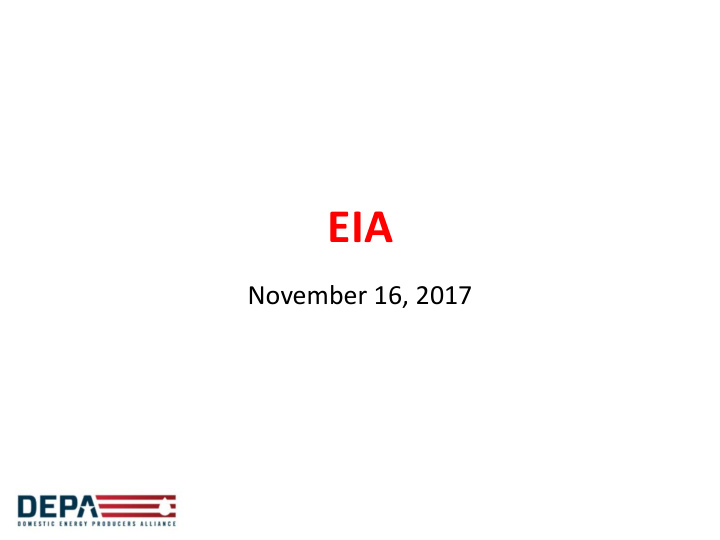



EIA November 16, 2017
New Era Of Energy In America Requires Even More Sophisticated Methods Of Forecasting EIA data is on a world stage as the U.S. is now the world’s swing producer. American Energy U.S. in Perceived Terminal Decline Renaissance 2 Source: EIA.
EIA Still Overstating 2017 Exit Rate Forecasts Although EIA reduced their forecasts in September after DEPA’s August presentation, they remain on the high side by 220,000 bbls or more. 9.82 9.72 9.69 9.69 Actual Production Very Flat 9.23 9.20 9.16 9.12 9.10 1.05 0.92 0.95 0.92 Y/Y Y/Y Y/Y Y/Y 8.77 Growth Growth Growth Growth 2017 Exit Rate EIA Forecasts 2016 Exit Apr-17 May-17 Jun-17 Jul-17 Aug-17 (Aug-17) (Sep-17) (Oct-17) (Nov-17) Rate (Aug-17) (Sep-17) (Oct-17) (Nov-17) (Million Barrels per Day) 3
Price Impact Of Libya/Nigeria Adding 400,000 Bbl/d Price Decreased By $10 (20%) From April – June 2017 32.7 $56 OPEC Crude Oil Production (mbbl/d) 32.6 Unexpected $54 $53 Libya/Nigeria 32.5 $52 Production WTI Price ($/bbl) 32.4 $50 0.46 32.3 $48 32.2 $46 0.33 32.1 $44 32.0 0.02 $42 31.9 $43 Base OPEC Production 31.8 $40 4
U.S. Oil Rig Count 800 750 700 650 600 550 500 5 Sources: Baker Hughes.
U.S. Production By Public Reporting Companies: 2Q 2017 13 Companies Total 2Q17 Production: Down 582,870 -139,485 Boe/d Raised Boe/d Down .78% 443,385 Boe/d 28 Companies 6 Sources: Company Public Filings.
U.S. Production By Public Reporting Companies: 3Q 2017 27 Companies Total 3Q17 Production: Down 357,300 -57,300 Boe/d Raised Boe/d Down .53% 300,000 Boe/d 12 Companies 7 Sources: Company Public Filings.
Unrealistic Growth Projections Disadvantage U.S. Market • Brent, the overseas benchmark, trades at an artificially elevated premium to WTI because U.S. growth is overstated. • This is a 10% disadvantage. • This puts America last, not first. 8 Source: Bloomberg.
What Has The Forecast Cost the U.S. in 2017? $4 Billion In Revenue, Royalties And Associated Tax Dollars Spread should have tightened, but high EIA U.S. production estimates kept WTI depressed Today’s Cushing inventory levels imply a $2-$3 spread, not $7 Harvey caused a further increase to the spread, but much of the damage to perception was already done 9 Sources: EIA, Bloomberg.
EIA Must Be Responsive To Changing Dynamics On A Timely Basis • Considering that the U.S. energy industry has the capability to oversupply the market, the EIA should engage industry to understand and respond to critical market dynamics. • Capital markets have changed. Shareholders want return on their investment. Growth at any cost / cash flow neutral no longer applies. 10
U.S. Production Growth Has Moderated Exceptionally Large Growth Required To Catch Up To EIA’s Projections 129,400 bbl/d m/m EIA Projected Growth Rate From Feb-Aug 2017, growth has been a total of 130,000 bbl/d 59,100 bbl/d m/m Actual Growth Rate 11 Source: EIA.
Permian Growth Per EIA Drilling Productivity Report (Nov-17) 120,000 Actual Avg. Permian m/m Growth Forecasted Avg. = 40,400 Bbl/d Permian m/m Growth = 59,600 Bbl/d 100,000 Bbl/d Growth m/m 80,000 60,000 40,000 20,000 0 12
Well Performance Projections Are Overstated Many in the industry expected new well productivity gains to continue by as much as 120% per well this year. But as plays mature, new well productivity has declined as more child infill wells have been drilled on pads. • These parent wells were unbounded. • Child wells have underperformed parent wells 15-20% in all the shale plays except the Bakken. 13 Sources: Oil and Gas Journal, WoodMac.
The Market Is Taking Notice Of EIA Discrepancies 14 Sources: EIA, Bloomberg, 11-9-2017 Daily Oil Brief.
Key Points To Integrate Into Forecasts Moving Forward 1. U.S. production growth has moderated 2. Performance projections are overstated 3. Efficiencies are peaking 4. Market pinch points are occurring that limit production (oil and gas pipelines, water handling, infrastructure, etc.) 5. Shareholders are demanding return on investment 15
Recommend
More recommend